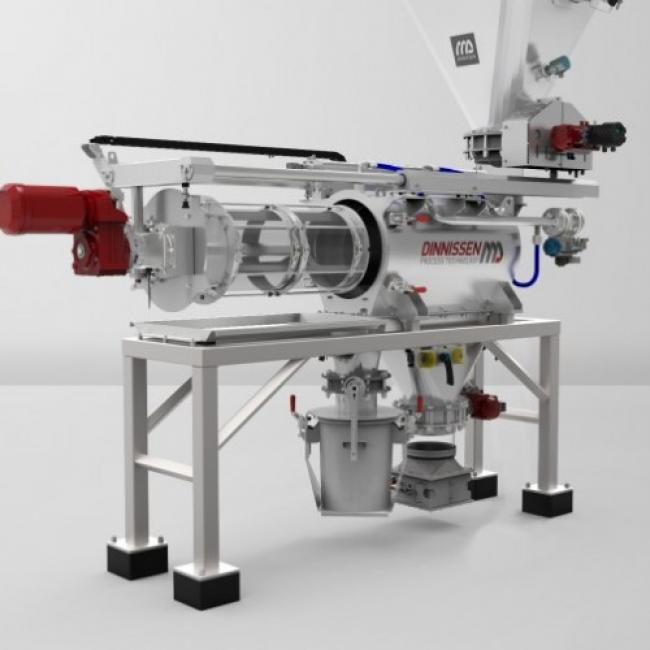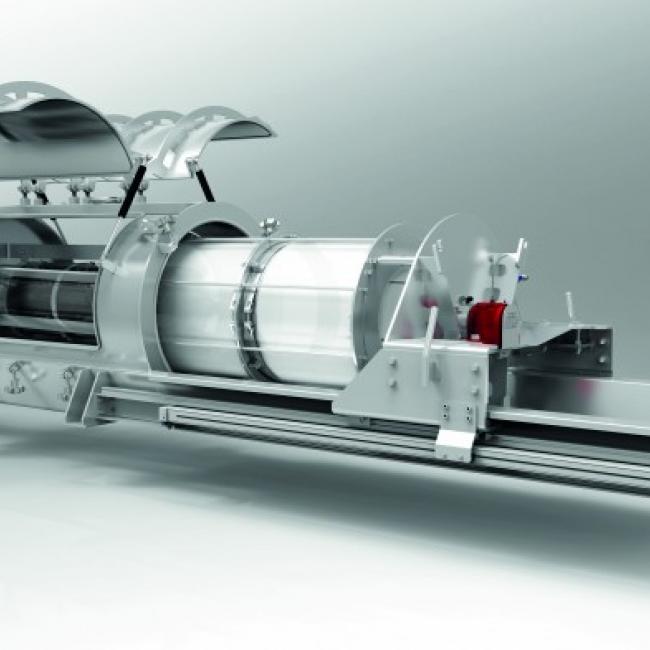Largest centrifugal sifter with ATEX zone 20 internal type approval
Largest centrifugal sifter with ATEX zone 20 internal type approval
Producers that process bulk goods can scale up considerably thanks to the unique new sifter, with a capacity of 25 - 30(!) tonnes of product per hour.
Since 1948, Dinnissen Process Technology has been developing machines, complete processes and customised solutions for the food, feed, pet food and chemical industries. The focus mainly lies on the efficient handling and processing of powders, granulates and pellets.
Innovation is the basis
One of Dinnissen’s characteristic qualities is to transform daring innovations into working concepts that are successfully adapted by the largest producers in the world.
A great example of such a successful innovation is the vacuum core coating process, invented by Dinnissen in 1992. Several years later this was followed by the lean gravity mixing lines and the hammer mill featuring an automatic sifter exchange system. These are just a few of the many technical breakthroughs that gained Dinnissen considerable recognition throughout the world.
Largest centrifugal sifter on the market
Recently another page was added to Dinnissen’s long series of great technical achievements. It concerns the CZ6 centrifugal sifter with a processing capacity of 25 – 30 tonnes of product per hour. Ideal for large processors of bulk products. The product is fed via a special inlet system into the top of the machine, where rotating blades bring the product in motion. Thanks to the centrifugal forces, the product is very evenly distributed over the entire sifter screen area, while the larger (unwanted) particles are effectively diverted to a separate outlet of the machine. Here, an easily accessible hatch allows the non-sifted/ desired waste product to be removed.
Use of ultrasound
To process very fine products smaller than 75 μm is possible. However, when processing certain types of product, in some cases a nylon sifter does not meet the set requirements. In that case, it is possible to use an sifter screen made of stainless steel. Once again, Dinnissen devised a solution that uses ultrasound to vibrate the sifter at a high frequency, allowing the product to be rapidly and efficiently transported in the desired way through the sifter.
Closable coarse outlet
This specific application is often used for inline sifting in a positive pneumatic conveying system.
Large inspection hatches for easy inspection and cleaning
Because hygiene regulations are becoming ever more stringent, it is obvious that the machine operator must have easy access to the parts that are sensitive to contamination. Therefore, this sifter solution is fitted with ergonomically designed Wingdoors; these are large inspection hatches that offer easy access for inspection of the sifter holders. If the products being processed are frequently changed all CZ-sifters are equipped with a full access slide out system. Dependent on the type of process, the product application and the desired technology, Dinnissen provides you a customer-specific solution that will be fully integrated in your existing production line.
Notified Body approval
Sifters that must be integrated in a pneumatic process, where the design overpressure exceeds 0.5 bar, must comply with additional requirements and must be subjected to a special PED (Pressure Equipment Directive) inspection. After all, in the event of permanent overpressure, the material from which the machine is made can crack, leak, permanently deform or present a higher risk of a dust explosion. In this area as well, Dinnissen has its technology secured. With respect to this sifter, after a successful PED inspection, it was delivered complete with an approved Notified Body certificate.
Type approval for ATEX zone 20
Moreover, this unique machine has ATEX zone 20 internally type approval. A major advantage. After all, based on the European ATEX 153 Directive, producers are statutorily obliged to indicate ATEX zones where explosive substances are present. This zone classification must be included in the explosion safety document. The explosion risk is identified based on a risk inventory and evaluation. Here the link is made with the ATEX 114 Directive that is sub-divided into categories, making clear in which zone the machine will not ignite an explosive atmosphere. The zones that run a risk of a dust explosion are indicated with zone 20, 21, 22. Thanks to the ATEX zone 20 type approval, you can integrate this Dinnissen sifter within your production lines without risk.


